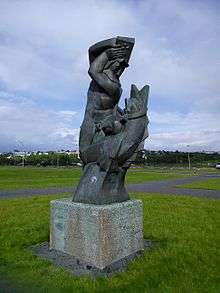Ásmundur Sveinsson
| Ásmundur Sveinsson | |
|---|---|
| Born |
Ásmundur Sveinsson May 30, 1893 Kolsstadir, Iceland |
| Died |
9 December 1982 (aged 89) Reykjavík |
| Nationality | Icelandic |
| Known for | sculpting |
Ásmundur Sveinsson was an Icelandic sculptor, was born at Kolsstadir in West Iceland on May 20, 1893 and died in Reykjavík on December 9, 1982.
Early years
In 1915 Ásmundur moved to Reykjavík where he enrolled in the Technical College of Iceland and apprenticed with sculptor Ríkarður Jónsson for four years. In 1919 he relocated to Copenhagen, Denmark, and from there to Stockholm, Sweden, where he enrolled in the Academy of Fine Arts where he remained for six years, much of it spent studying with sculptor Carl Milles. In 1924 he married sculptor Gunnfríður Jónsdóttir, whom he later divorced. After graduating from the Academy, Ásmundur moved to Paris, France where he continued his study, here under the sculptor Charles Despiau.
Work

Ásmundur returned to Iceland in 1929 and began producing a series of abstracted figurative works. His themes were often men and women at work and included such pieces as, The Blacksmith, The Washer Women and The Water Carrier. During the 1940s Ásmundur's work moved even farther away from the human and animal form that had been his mainstay until then and by the 1950s he was producing work that was almost entirely abstract. Like many Icelandic artists Ásmundur drew upon the traditions of his native country when seeking subjects to inspire him. These include Trollwoman, (1948), Head Ransom, (1948), based on a poem that Egil Skallagrimsson composed to save his own head and bleep-Ride, (1944) taken from the Prose Edda of Snorri Sturlusson. His Sæmundur and the Seal, also in this vein, is situated in front of the main building of the University of Iceland in Reykjavík. Generally, the artist believed in placing works of art not only in the hands of a small elite, but also in making them accessible to the public. Other works of Ásmundur Sveinsson are to be found on the hill Öskjuhlíð near Perlan in Reykjavík or at the farm of Borg á Mýrum near Borgarnes. The abstract sculpture here represents the saga hero Egill having his dead son in his arms. The title Sonartorrek is referring to a poem which Egill Skallagrimsson wrote about this scene.
Ásmundarsafn
The former house of the artist in Laugardalur, Reykjavík, has been installed as a museum, called Ásmundarsafn. The house was constructed in the 1930s, based on designs drawn by the artist who was a fan of the Bauhaus style. The house is slightly reminiscent of Le Corbusier and his chapel of Ronchamp. The sculpture garden nearby is open to public.
See also
External links
- http://www.listasafnreykjavikur.is/Asmundarsafn/asmundarsafn.en.shtml
- http://www.borgarfjordur.com/pages/p7.html